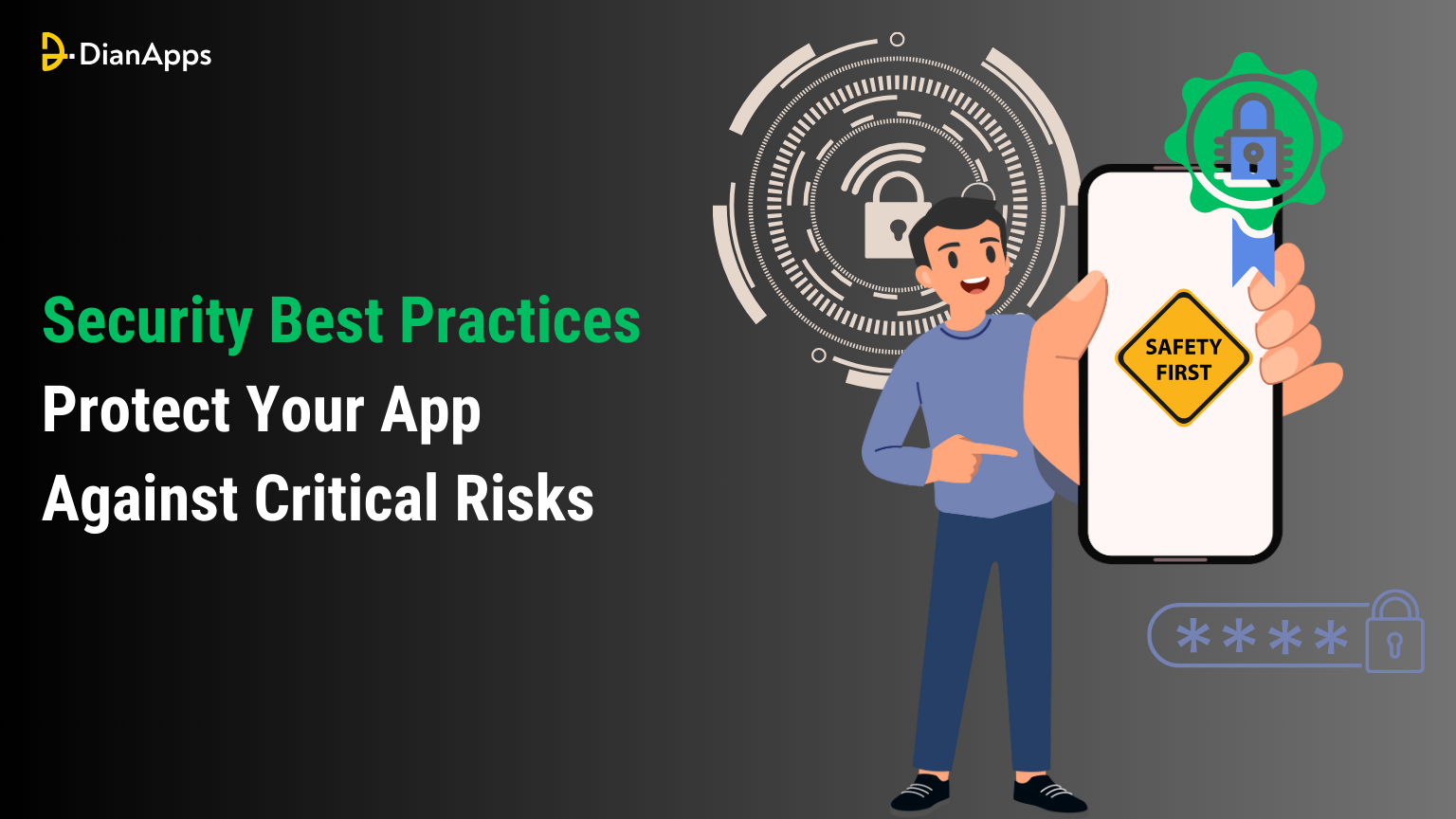Security Best Practices: Protect Your App Against Critical Risks
Have you ever wondered what a single security vulnerability could cost your app? In today’s hyper-connected world, where apps are at the center of everything we do—from creating a banking app to shopping and social networking—the stakes for app security have never been higher. A tiny loophole can snowball into a catastrophic breach, leading to stolen data, financial losses, and a tarnished reputation.
Consider this: global cyberattacks are rising at an unprecedented rate, with reports showing that businesses face an attack every 39 seconds. The question isn’t if your app will be targeted but when. And when it happens, will your app be ready to withstand the threat?
This blog will take you through practical, battle-tested security best practices to shield your app from critical risks. Whether you’re an app developer, business owner, or tech enthusiast, these insights will help you build a robust defense against today’s ever-evolving cyber threats. Ready to safeguard your app? Let’s dive in!
Understanding Critical Risks in App Security
App security isn’t just about adding a password field or enabling encryption—it’s about understanding the threats that lurk behind every line of code and interaction. To effectively protect your app, you need to first identify the critical risks it faces. Here’s a closer look at some of the most pressing vulnerabilities:
1. Common Security Risks
1.1 Data Breaches and Leaks
Sensitive user information, including personal details, payment data, and credentials, can be exposed due to poor security measures. Breaches not only harm users but can also result in heavy regulatory fines and loss of customer trust.
1.2 Injection Attacks (e.g., SQL Injection, Cross-Site Scripting)
These attacks occur when malicious actors inject harmful code into your app, exploiting weaknesses to gain unauthorized access or disrupt operations. They remain one of the top threats in web and mobile applications.
1.3 Man-in-the-Middle (MITM) Attacks
Insecure communication channels can allow attackers to intercept and manipulate data exchanges between users and your app, potentially exposing sensitive information.
1.4 Malware and Ransomware
Cybercriminals can embed malicious software into your app or systems, hijacking data and operations for financial or strategic gains.
1.5 Insider Threats
Sometimes, the danger comes from within. Employees or contractors with access to sensitive data can inadvertently or maliciously compromise security.
2. The Impact of Security Breaches
The consequences of a security failure go far beyond the technical realm:
- Financial Losses: Businesses often lose millions recovering from breaches, including costs for legal fees, fines, and compensation.
- Reputational Damage: Customers lose faith in apps that can’t secure their data, leading to a significant decline in user retention.
- Operational Disruption: Breaches often lead to downtime, affecting the app’s availability and functionality.
3. Real-World Examples of Security Failures
- Facebook (2019): A database containing 540 million records, including user comments, account names, and likes, was left exposed on a public server.
- Equifax (2017): A massive breach exposed the personal information of 147 million people due to a vulnerability in their web application.
- Uber (2016): Hackers gained access to sensitive user and driver data because of weak access controls, leading to a hefty $148 million settlement.
By recognizing these risks and their potential impacts, you lay the foundation for building a secure app that protects both your users and your brand. Next, let’s explore the actionable steps you can take to mitigate these threats.
Security Best Practices for App Protection
Understanding the risks is only half the battle; implementing effective security measures is where true protection begins. Let’s explore key practices to safeguard your app against critical risks.
1. Secure Development Practices
The foundation of a secure app lies in its development. Developers should adhere to secure coding standards, such as the OWASP Secure Coding Practices, to minimize vulnerabilities.
Regular code reviews and the use of static code analysis tools are essential to catch potential flaws early.
Furthermore, validating all user inputs is crucial to prevent injection attacks like SQL Injection and Cross-Site Scripting (XSS), which exploit weak input handling.
2. Authentication and Authorization
A robust authentication and authorization system is critical for controlling access to your app. Implementing multi-factor authentication (MFA) provides an additional layer of security beyond traditional passwords, reducing the risk of unauthorized access.
Role-Based Access Control (RBAC) further enhances protection by ensuring users can only access data and features relevant to their roles. To prevent brute-force attacks, enforce strong password policies that mandate complexity and regular updates.
3. Data Protection
Data is at the heart of your app, making its protection a top priority. Sensitive data should always be encrypted using robust protocols like AES for data at rest and TLS for data in transit.
Secure APIs are equally important; they must be authenticated and use HTTPS to prevent unauthorized access and data interception.
Also read the importance of securing HTTPS with certificate pinning on Android
Adopting a data minimization strategy—collecting only what is absolutely necessary—can further limit the impact of a potential breach.
4. Regular Updates and Patching
Security threats evolve rapidly, and staying ahead of them requires a proactive approach to updates and patching. Outdated software libraries and frameworks often contain known vulnerabilities, making them easy targets for attackers.
Regularly monitor dependencies and use tools like Dependabot to stay updated. Additionally, maintain an active program for identifying and addressing vulnerabilities promptly to mitigate risks.
5. Network Security
Your app operates within a networked environment that also requires robust security measures. Firewalls, such as Web Application Firewalls (WAF), can help block malicious traffic and prevent common attacks.
Communication protocols should be secured with HTTPS and TLS 1.3 to protect data exchanges. Restricting access through IP whitelisting adds another layer of protection, ensuring that only trusted sources can interact with your app’s critical components.
6. Monitoring and Incident Response
Despite best efforts, no app is entirely immune to security breaches, which is why monitoring and incident response is vital.
Continuous monitoring tools can detect suspicious activities in real time, providing early warnings of potential threats.
Alerts should be configured for unusual patterns, such as repeated login attempts or high data transfer volumes.
Equally important is having a well-defined incident response plan, outlining steps to mitigate damage and notify affected parties promptly in case of a breach.
By integrating these practices into your development and operational processes, you can significantly reduce your app’s exposure to critical risks.
Tools and Technologies to Enhance App Security
In the ever-evolving landscape of cybersecurity, leveraging the right tools and technologies is essential to stay ahead of potential threats. These tools not only bolster your app’s defenses but also streamline the implementation of security measures. Let’s explore some of the most effective solutions available.
1. Application Security Testing Tools
Security begins with identifying vulnerabilities in your app before attackers can exploit them. Tools like Snyk, Veracode, and Burp Suite offer comprehensive application security testing.
These solutions provide functionalities such as static application security testing (SAST), dynamic application security testing (DAST), and interactive application security testing (IAST).
By integrating these tools into your development pipeline, you can detect and fix vulnerabilities at every stage of development.
2. Encryption and Key Management Solutions
Data encryption is a critical component of app security, and using robust encryption tools ensures your sensitive data remains protected.
Solutions like HashiCorp Vault and AWS Key Management Service (KMS) enable secure encryption of data and proper key management.
These tools simplify implementing strong encryption algorithms while ensuring that keys are rotated, stored securely, and accessed only by authorized entities.
3. Web Application Firewalls (WAFs)
Web Application Firewalls serve as the first line of defense against malicious traffic targeting your app. Tools like AWS WAF, Cloudflare WAF, and Imperva protect apps by filtering and monitoring HTTP requests, blocking suspicious activity such as SQL Injection or Cross-Site Scripting (XSS) attempts. WAFs are essential for apps exposed to the internet, ensuring real-time threat mitigation.
4. Identity and Access Management (IAM) Systems
IAM systems help manage user identities and control access to sensitive resources. Platforms like Okta and Auth0 provide robust identity verification mechanisms, including multi-factor authentication (MFA), single sign-on (SSO), and role-based access controls (RBAC).
By centralizing authentication and authorization processes, IAM systems reduce vulnerabilities associated with weak or inconsistent access management.
5. Real-Time Monitoring and Threat Detection
Continuous monitoring is vital for detecting anomalies and responding to security threats promptly. Tools like Splunk, Datadog, and Azure Sentinel offer real-time analytics and threat detection.
These platforms use machine learning to identify patterns indicative of potential breaches, ensuring your team can act swiftly to mitigate risks.
6. Secure API Management Platforms
With APIs being an important component of most apps, securing them is non-negotiable.
Tools like Postman API Security, Apigee, and RapidAPI provide features such as API authentication, encryption, and monitoring.
These platforms ensure your APIs are well-protected against unauthorized access and misuse.
Also read: Things developers must know before investing in API development
7. Backup and Disaster Recovery Solutions
Even the best security measures cannot guarantee absolute protection, which makes backup and disaster recovery essential.
Tools like Veeam and Rubrik offer automated backups, ensuring that your app’s data and configurations can be restored quickly in the event of an attack or system failure.
By integrating these tools and technologies into your security strategy, you can strengthen your app’s defenses, ensure compliance with industry standards, and build trust with your users.
Future-Proofing Your App Against Emerging Threats
As the digital landscape evolves, so do the threats that apps face. Future-proofing your app requires a proactive approach to security, ensuring your defenses are adaptable to new vulnerabilities and attack vectors. Here are some strategies to help you stay ahead of the curve:
1. Stay Informed About Emerging Threats
Cybersecurity is a constantly evolving field, with new risks surfacing regularly. Make it a priority to stay updated on the latest threats by following trusted sources like the OWASP Foundation, CERT, and industry-specific security forums. By understanding emerging trends, you can anticipate and prepare for potential risks before they impact your app.
2. Adopt Zero Trust Architecture
The Zero Trust model operates on the principle of “never trust, always verify.” This approach assumes that threats could exist both outside and within your network. By implementing Zero Trust, you can enforce strict access controls, monitor user activity, and continuously validate the security of all users, devices, and connections within your app ecosystem.
3. Regularly Conduct Penetration Testing
Penetration testing, or ethical hacking, helps identify and address vulnerabilities that could be exploited by attackers. Conduct regular testing to evaluate the effectiveness of your app’s security measures and simulate potential attack scenarios. Engaging third-party experts for unbiased assessments can further strengthen your security posture.
4. Leverage Artificial Intelligence (AI) for Threat Detection
AI-powered security tools offer advanced capabilities for detecting anomalies and identifying potential threats. By analyzing vast amounts of data, these tools can detect subtle patterns indicative of malicious activity, often before human analysts can. Incorporating AI into your security strategy can provide an edge in combating sophisticated attacks.
Also read: Why are AI Cybersecurity solutions important?
5. Foster a Security-First Culture
Your app’s security is only as strong as its weakest link, and often, that link is human error. Foster a security-first culture within your organization by educating employees about best practices, phishing awareness, and secure coding principles. Encourage developers, testers, and stakeholders to prioritize security in every aspect of app development and maintenance.
6. Plan for Scalability and Compliance
As your app grows, so will its security needs. Design your app’s architecture to scale with additional users, data, and features without compromising security. Simultaneously, ensure compliance with evolving regulations like GDPR, HIPAA, or CCPA, as non-compliance can result in legal penalties and reputational damage.
7. Invest in Threat Intelligence
Threat intelligence provides insights into the tactics, techniques, and procedures used by attackers. By leveraging threat intelligence platforms, you can gain actionable information about potential risks specific to your industry or app. Use these insights to refine your security measures and stay ahead of adversaries.
Future-proofing your app is an ongoing process that demands vigilance, adaptability, and a commitment to innovation. By implementing these strategies, you can ensure your app remains resilient against both current and emerging threats.
Conclusion
In a world of evolving cyber threats, app security is no longer optional—it’s essential. By understanding critical risks, implementing robust security practices, and leveraging the right tools and strategies, you can safeguard your app and user data.
Prioritizing security today ensures a resilient and trustworthy app for tomorrow. Stay proactive, stay protected.
Ready to secure your app? Reach out to our team of experts at DianApps to get tailored security solutions that keep your app safe against emerging threats. Let’s build a secure future together!




